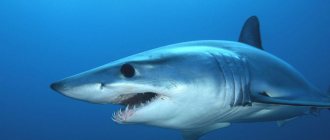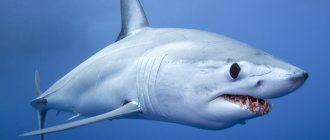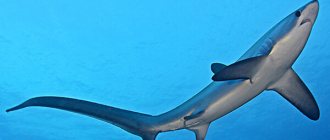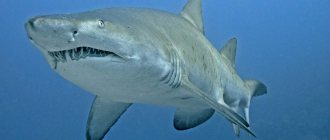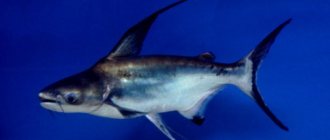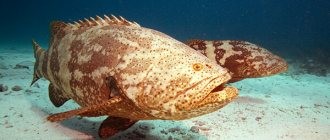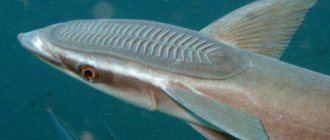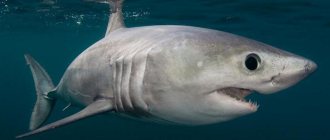- Wild animals
- >>
- Fish
The hammerhead shark is one of the most unusual marine inhabitants.
It stands out sharply from other inhabitants of the deep sea with the shape of its head. Visually, it seems that this fish is experiencing terrible discomfort when moving. This shark is considered one of the most dangerous and powerful predatory fish. In the history of existence, scientists cite cases of attacks on humans as well. According to the compiled rating, it takes an honorable third place on the pedestal of merciless bloodthirsty predators, second only to the white and tiger shark.
In addition to its unusual appearance, the fish is distinguished by its high speed of movement, lightning-fast reactions and impressive size. Particularly large individuals can reach a length of more than 6 meters.
Origin of the species and description
Photo: Hammerhead Shark
Hammerhead sharks belong to the class of cartilaginous fish, the order Carchariformes, the family of hammerhead sharks, and are classified in the genus Hammerhead sharks; the species is the giant hammerhead shark. The hammerhead fish, in turn, is divided into 9 more subspecies.
To date, there is no reliable information about the exact period of birth of these representatives of flora and fauna. According to the results of the research, zoologists have come to the conclusion that presumably the ancestors of modern hammerhead predators already existed in the depths of the sea 20-26 million years ago. It is generally accepted that these fish originated from representatives of the sphyrnidae family.
Video: Hammerhead Shark
These predators have a very threatening appearance and a very specific head shape. It is flattened, elongated on the sides and as if divided into two halves. It is this feature that largely determines the lifestyle and feeding patterns of marine predators.
To date, scientists have disagreed about the formation of such forms. Some believe that this appearance is a consequence of multi-million dollar changes, others believe that a gene mutation played a role.
At the moment, the number of fossils from which it is possible to reconstruct the evolutionary path of hammerhead predators is negligible. This is due to the fact that the basis of a shark’s body, the skeleton, consists not of bone tissue, but of cartilage, which decomposes quite quickly, leaving no traces.
Over many millions of years, due to their unusual appearance, hammerhead sharks have learned to use special receptors rather than their visual organs for hunting. They allow fish to see and find their prey even through thick sand.
How do hammerhead sharks reproduce?
Hammerhead sharks belong to the category of viviparous fish. However, the process of their mating still remains a closely guarded secret, since there are few observers of this rare phenomenon.
It is only known that males tend to show unbridled temperament during an act of love, which is why females have to heal for a long time after such sexual games.
And a year after mating, the shark brings 30-40 well-swimming sharks, 40-50 cm each - such a respectable size and the ability of the babies to move quite quickly in the water helps them survive in a hostile world, and this is not a metaphor, since there are more than enough dangerous predators around .
Nature has taken care to make the birthing process easier for the shark and its cubs, which is why the hammer-shaped head of newborns is deployed along the body.
Watch video - A pregnant hammerhead shark gives birth on the shore:
Appearance and features
Photo: Dangerous hammerhead shark
The appearance of these representatives of marine flora and fauna is very peculiar and very threatening. They are difficult to confuse with any other species. They have an amazingly shaped head, which, due to bone growths, is elongated and extended to the sides. On both sides of this outgrowth there are organs of vision. The iris of the eyes is golden yellow. However, they are not the main guide and assistant in finding prey.
The skin of the so-called hammer is densely dotted with special, ultra-sensitive receptors that make it possible to detect the slightest signals of a living creature. Thanks to such receptors, sharks managed to perfectly master the skill of hunting, so the prey has virtually no chance of salvation.
The eyes of fish are protected by a nictitating membrane and eyelids. The eyes are located exactly opposite each other, which allows sharks to keep almost the entire area around them in their field of vision. This arrangement of the eyes allows you to cover the territory 360 degrees.
Not so long ago, there was a theory that this particular head shape helps fish maintain balance and develop greater speed when moving underwater. However, today this theory is completely dispelled, as it has no evidence base.
Scientists have proven that maintaining balance is ensured by the unusual structure of the spine. A characteristic feature of bloodthirsty hunters is the structure and arrangement of their teeth. They are triangular in shape, directed towards the corners of the mouth and have visible serrations.
The body of the fish is smooth, elongated, spindle-shaped with well-developed, strong muscles. The shark's body is dark blue on top and off-white underneath. Thanks to this color, they practically merge with the sea.
This type of sea predator rightfully bears the title of giants. The average body length is 4-5 meters. However, in some regions there are individuals reaching a length of 8-9 meters.
Hammerfish: interesting facts and details
In addition to its amazing external characteristics, this underwater inhabitant surprises with the following details:
- If the fish is in shallow water, the hammerhead shark's skin may become tanned. No one on the planet has this ability except humans and pigs.
- The largest hammerhead fish caught by a person reached almost 8 meters, and at the same time its weight was equal to 363 kilograms.
- This predator has no enemies except parasites and humans.
- This fish needs to constantly move to be in a “buoyant” state, since it does not have an air bladder.
- These sharks see a three-dimensional “picture” due to their widely spaced eyes. The larger the hammer, the better the view. Although she cannot see directly in front of her, constant movements of her head allow her to “put together” the image into one whole.
- Hammerhead sharks can prey on their slightly smaller sisters.
- These are the only fish that are not afraid of stingray poison.
- Their body is so flexible that it can “fold” almost in half.
- Females compete for position in the middle of the school. This is where males try to get to in order to get the strongest “girlfriend”.
- Mating of hammerheads has been virtually unknown to humans.
Where does the hammerhead shark live?
Photo: Hammerhead shark fish
This type of fish does not have a strictly limited habitat. They love to move from one region to another and travel long distances. They mainly prefer regions with warm, temperate and tropical climates.
The largest numbers of this species of marine predators are observed near the Hawaiian Islands. That is why practically only the Hawaiian Research Institute is engaged in studying the characteristics of life activity and evolution. The hammerhead fish lives in the waters of the Atlantic, Pacific and Indian oceans.
Habitats of marine predators:
- from Uruguay to North Carolina;
- from Peru to California;
- Senegal;
- coast of Morocco;
- Australia;
- French polynesia;
- Ryukyu Islands;
- Gambia;
- Guinea;
- Mauritania;
- West Sahara;
- Sierra Leone.
Hammerhead sharks are found in the Mediterranean and Caribbean seas, in the Gulf of Mexico. Bloodthirsty predators like to gather near coral reefs, sea plumes, rocky sea cliffs, etc. They feel great at almost any depth, both in shallow water and in the vast ocean more than 70-80 meters deep. Gathering in flocks, they can move as close to the shore as possible, or go out into the open ocean. This type of fish is subject to migration - in the warm season they migrate to regions of higher latitudes.
Now you know where the hammerhead shark is found. Let's see what this fish eats.
What does it look like
Almost everyone is primarily attracted by the appearance of the fish. The body looks like a shark. It has a streamlined shape. Color is influenced by gender. In general, sharks have a dark back – brown or gray. The belly is light. Most of all, many are interested in the head, or rather the shape. It is T-shaped. The structure of the head is influenced by the “breed” of the fish.
The head can be small or large. The main difference between fish is that they have unique shapes. For this reason, the sea dweller was nicknamed the hammerfish. The eyes are located at the tips of the “shoots” of the head. Sharks are unique because they can see what is happening around them 360 degrees. The predator's vision is affected by the latitude of the hammer. The smaller the size, the worse the visibility in front of the hammer fish.
What does a hammerhead shark eat?
Photo: Great hammerhead shark
The hammerhead shark is a skilled predator that has virtually no equal. The victim she has chosen has virtually no chance of salvation. There are even cases of attacks on humans. However, a person is in danger if he himself provokes a predator.
Sharks' teeth are relatively small, which does not allow them to hunt large sea creatures. The food supply of hammerhead fish is very diverse. The majority of the diet consists of small marine invertebrates.
What is the source of food:
- crabs;
- lobsters;
- squid;
- octopuses;
- sharks that are inferior in strength and size: dusky, gray, gray mustelids;
- stingrays (are a favorite delicacy);
- catfish;
- seals;
- croakers;
- perches;
- flounder;
- toad fish, hedgehog fish, etc.
In nature, there have been cases of cannibalism when hammerhead sharks ate their smaller relatives. Predators hunt mainly at night. They are distinguished by dexterity, agility, and high speed of movement. Thanks to lightning-fast reactions, some victims do not even have time to realize that they have been caught by predators. Having caught its prey, the shark either stuns it with a powerful head blow, or presses it to the bottom and eats it.
Sharks tend to feed on many poisonous fish and marine life. However, the shark’s body has learned to develop immunity and develop resistance to various poisons.
Eat a varied diet
The hammerhead shark hunts for a variety of prey, its goal is everything that can be tasty and is in its teeth. Its diet includes various fish, squid, various mollusks, and crustaceans.
The hammerhead shark happily hunts stingrays and other species of sharks that are smaller than it. Cases of cannibalism have been recorded among individuals; large hammerhead sharks happily eat smaller ones. But the hammerhead shark itself also risks being harmed by the teeth of a predator. The young are often eaten by the bloodthirsty and ferocious bull shark.
@ dsabo — depositphotos.com
Features of character and lifestyle
Photo: Giant hammerhead shark
Hammerhead sharks are incredibly agile and fast sea creatures, despite their impressive size. They feel great both in the open ocean at great depths and in shallow waters. During the day they mostly rest. Females prefer to spend time in each other's company near coral reefs or sea cliffs. They go hunting with the offensive.
Interesting fact: Female hammerhead sharks like to gather in groups in underwater rocks. Most often this happens during the day; by night they disperse, only to gather again the next day and spend it together.
It is noteworthy that predators are perfectly oriented in space even in complete darkness and never confuse the parts of the world. It has been scientifically proven that in the process of communicating with each other, sharks use about a dozen different signals. About half of them are intended to warn of danger. The meaning of the rest is still unknown.
It is known that predators feel great at almost any depth. Most often they gather in schools at a depth of 20-25 meters; they can gather in shallow water or sink almost to the bottom of the ocean, diving to a depth of more than 360 meters. There are known cases when this type of predator was found in fresh waters.
With the onset of the cold season, migrations of these predators are observed. At this time of year, the bulk of predators concentrate near the equator. With the return of summer, they migrate again to cooler waters rich in food. During the migration period, young individuals accumulate in huge flocks, the number of which reaches several thousand.
They are considered virtuoso hunters, often attacking inhabitants of the deep sea that are significantly larger than them in size and strength.
Family Hammerheads
Scientists know nine species of hammerhead sharks, differing in color, size, head shape and the waters in which they live. This whole family is divided into two genera: Eusphyra and Sphyrna. In the first group there is only one representative - the wing-headed shark. Her “hammer” is equal in size to almost half of her body, and the width of her head differs from other representatives of this family. There are eight more “sisters” in the second group, the largest of which can reach 6 meters. This entire family is related to felids, mustelids and gray sharks.
Social structure and reproduction
Photo: Baby hammerhead shark
The hammerhead shark is a viviparous fish. They reach sexual maturity when they reach a certain weight and body length. Females predominate in body size and weight. Mating does not occur at depth; during this period, sharks are as close as possible to the surface of the deep sea. During the mating process, males often sink their teeth into their partners.
Each adult female bears offspring once every two years. The gestation period of the embryo lasts 10-11 months. The period of birth in the northern hemisphere occurs in the last days of spring. Sharks, whose habitat is located on the Australian coast, have to give birth at the end of winter.
Interesting fact: In hammerhead shark babies, the hammer is located parallel to the body, which prevents injuries to females during childbirth.
As birth approaches, the female approaches the shore and lives in small bays where there is plenty of food. The cubs that are born immediately fall into a natural position and follow their parents. At one time, one female gives birth to from 10 to 40 cubs. The number of small predators directly depends on the size and body weight of the mother.
Juveniles are approximately half a meter long and are excellent, very fast swimmers. For the first few months, newborn sharks try to stay close to their mother, since during this period they are easy prey for other predators. During the period of being close to their mother, they receive protection and master the intricacies of hunting. After the born cubs are strong enough and have gained experience, they separate from their mother and lead a separate lifestyle.
Gigantic
Because of their large fins, the basking hammerhead shark is hunted mercilessly. This species is listed in the International Red Book as endangered. In Asian markets, high-priced predator fins are the basis for the famous “shark fin soup.”
The main differences between giants and their relatives:
- the front edge of the hammer is almost flat without bending, which gives the head a rectangular shape;
- in size it exceeds all types;
- They bear offspring once every two years; the litter ranges from 6 to 55 babies;
- life expectancy can reach 50 years.
Natural enemies of hammerhead sharks
Photo: Hammerhead shark in water
The hammerhead shark is one of the most powerful and dangerous predators. Due to their body size, power and agility, they have virtually no enemies in their natural habitat. The exception is humans and parasites that parasitize the shark’s body, practically eating it from the inside. If the number of parasites is large, they can lead to the death of even such a giant as a hammerhead shark.
Predators have attacked humans more than once. In a study of predators at the Hawaii Research Institute, it was proven that the shark does not consider humans as prey and potential prey. However, it is near the Hawaiian Islands that the most frequent cases of attacks on humans are recorded. This happens especially often during the period when females wash ashore before giving birth. At this moment they are especially dangerous, aggressive and unpredictable.
Divers, scuba divers, and tourists often fall prey to aggressive, pregnant females. Divers and explorers are also often targeted due to the sudden movements and unpredictability of predators.
Hammerhead sharks are often killed by humans due to their high value. A large number of medicines, as well as ointments, creams and decorative cosmetics are made from shark oil. Elite restaurants serve dishes prepared with shark meat. The well-known shark fin soup is considered a special delicacy.
Danger to humans
Despite the fact that the hammerhead shark does not consider humans as food, there are many cases of attacks by these predators on people around the world. In terms of the number of attacks on tourists, it ranks third among other dangerous predators.
Typically, attacks occur during the shark's breeding season, when it becomes more aggressive. At this time, she swims quite close to the coastline, where she finds food for herself and her future offspring. There are also many vacationers swimming there who engage in diving and other marine activities. Typically, tourists do not think that they could become a victim of a shark, and are not careful when meeting one, for which they pay with their lives.
This is interesting
Not long ago, a new (as some scientists believe) species of hammerhead shark was discovered. Interesting facts about special DNA, a different number of vertebrae (170, not the usual 190), genetics - all indicate that it “diverged” from the bronze shark approximately 4.5 million years ago. Now the question is about recognizing the new species and clarifying the status of the bronze hammerhead shark.
A little about predators with strange heads:
- the largest individual was caught near New Zealand, it was 789 cm long and weighed 363 kg;
- the peripheral vision of these fish is three times better than that of ordinary sharks;
- the record weight for these sharks (IGFA data) is considered to be 580.5 kg;
- they are among the three most dangerous sharks for humans;
- an adult giant hammerhead shark has no natural enemies; only humans or invertebrate parasites can harm it;
- The 50 Australian cent coin features an image of a hammerhead shark, with a mintage of 300,000;
- predators are perfectly oriented even in complete darkness, accurately identify all parts of the world and never go astray during migrations;
- In Hawaii, they believe that the souls of the dead move into hammerhead sharks; meeting them in the sea is a good sign.
